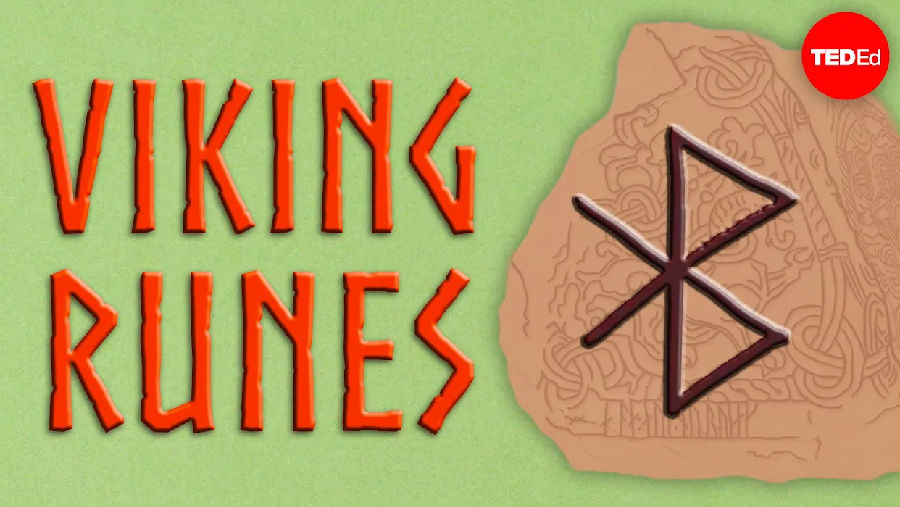In the 8th century CE, Vikings surged across the misty seas.
公元8世纪,维京人航行穿过浓雾笼罩的海洋。
They came from Scandinavia in Northern Europe but would travel far and wide.
他们从北欧的斯堪的纳维亚出发,向世界各地进发。
Some plundered and settled in the British Isles and France; others braved Artic exploration or forged clever new trade routes to the Middle East.
他们有的掠夺、侵占了不列颠岛屿和法国,有的进行了艰难的南极探险,还有的开辟了通向中东的新贸易通道。
With their steely navigational skills, advanced long-ships and fearsome tactics, the Vikings sustained their seafaring for over three hundred years.
凭借他们出色的航行技巧、先进的狭长快速战船和骇人的战术,三百年来,维京人延续着他们的航海事业。
But for all their might, they left few monuments.
尽管力量强大,但他们并未留下自己的痕迹。
Instead, fragments of stone, bark, and bone provide the keys to their culture.
人们只有从残留的石头、树皮和骨头的碎片中窥得他们的文化。
Found in graves, bogs, and sites of ancient settlements, many of these objects are inscribed with messages in Old Norse written in runic letters.
这些物品是在墓穴、沼泽和古村落遗址中被发现的,上面刻着用如尼文字写成的古斯堪的纳维亚语。
But the Vikings also scratched runes into household goods, jewellery, weapons, and even shoes.
除此之外,维京人也会在日常用品上刻下类似的文字,如珠宝、武器,甚至是鞋子上。
Deciphering these messages is no easy task.
破译其中的信息并非易事。
Runes are short, straight, and diagonal lines that make up an alphabet called the "futhark."
如尼字母由短的直线或斜线组成,其字母表被称为“futhark”。
All classes of people spoke and wrote this language, in many different dialects.
所有阶层的人都用这种语言读写,只是各地之间有一些出入。
There was no standard spelling, they wrote the individual runic letters by pronouncing the sounds of their regional accents.
如尼文字并没有标准的拼写方式,人们根据自己地区口音的发音方式来拼写。
Some of these inscriptions also bore the influence of other cultures the Vikings interacted with
一些碑文甚至体现了维京人所接触到的其他各地文化的影响,
the runic inscription "love conquers all," for example, is originally a Latin phrase from the poet Virgil.
比如,如尼文字表示的“爱战胜一切”,是一则来自诗人维吉尔的拉丁语短句。
Many, like the enigmatic Rok runestone, were carved in verse, highlighting the tradition of Old Norse poetry.
以神秘的Rok(瑞典城市)符文石为例,许多所刻文字也反映了古斯堪的纳维亚的诗歌文化。
So even though modern runologists can read runes, their meaning isn't always obvious.
所以即使现代如尼文字学家能够分辨如尼字母,辨清其中传达的信息却仍困难重重。
Still, in spite of the remaining mysteries,
不过,尽管还有不少文字的意义未知,
many inscriptions memorializing the dead and recording local histories have been deciphered -- along with some containing magical incantations.
那些用来纪念逝去之人的、记录当地历史事件的、以及包含魔法咒符的雕刻文字都已经被破译了。
The Ramsund runes in Sweden are carved on a rocky outcrop beside a bridge for travelers passing over swampy ground.
Ramsund符文被刻在了瑞典一座桥边的突出岩石上,该桥是为行人通过沼泽地所建。
This causeway was commissioned by a prominent local woman named Sigrior.
当地名声显赫的Sigrior女士委托人修筑了它。

She proclaimed both her importance and her family's power by carving their names in stone,
她让人在石头中刻上她和家人的名字,以此彰显自己和家人的影响力,
and even associated herself and her family with mythical heroism by carving illustrations of Sigurd the dragon slayer.
她甚至将自己以及家人与古代神话英雄联系起来,让人刻上了屠龙者Sigurd的故事。
In the town of Jelling in Denmark, two standing stones from the 10th century memorialize different generations of a royal family.
在丹麦的耶灵小镇中,伫立着两块10世纪时期的巨石,以纪念一个皇室家族的几代人。
The first was erected by King Gorm the Old in memory of his Queen Thyrvi, and the second by their son, Harald Bluetooth, after Gorm's death.
第一块是老葛姆国王为纪念他的王后丝德薇而竖立,第二块则是他们的儿子哈尔德·布鲁图斯为纪念父亲的去世而竖立。
The stones announce the power of this Viking Age dynasty, and they are among the earliest historical documents of Denmark.
这两块石头展现了维京时代的王朝统治力量,同时也是丹麦最早的历史文献之一。
They indicate that Denmark was the earliest major Viking Age kingdom, by telling that Harald controlled southern Norway, and that he converted to Christianity.
石头上记载了哈尔德控制了南挪威、以及他皈依基督教等事件,表明了丹麦是维京时代最早建立的重要王国。
Today, Harald Bluetooth's initials make up the Bluetooth logo.
如今,哈尔德·布鲁图斯的首字母成了“蓝牙”的图标。
The 10th century warrior poet Egil was a well-known carver of runes.
10世纪的战争诗人埃吉尔是著名的如尼文字雕刻家。
According to poetic accounts, he once carved runes on a horn filled with poison, causing the horn to shatter.
据诗学记载,他曾将如尼文字雕刻在盛满毒药的动物角上,这一举动粉碎了这只角。
In another story, Egil saves a young girl's life by placing a piece of whale bone carved with healing runes under her pillow.
在另一则记载中,埃吉尔通过在鲸骨上刻下有治愈效果的如尼文字,并将其放在一个年轻女孩的枕头下,以此救了她的命。
Norse poetry tells of runic spells, cast to ensure calm seas, safe childbirth and triumphant battles.
古斯堪的纳维亚语诗歌讲述了如尼文字的符咒如何使大海平静、孩子安全出生以及战争获得胜利。
But the exact nature of these spells isn't fully understood -- many of the inscriptions on swords, axes, and spears are indecipherable.
不过,人们未能彻底理解这些咒符确切的内涵,因为那些刻在剑、斧头、矛上的文字至今还无法破译。
Other objects, like the Lindholm amulet, have inscriptions that could be incantations, riddles, or religious messages.
而在诸如林霍尔姆护身符的其他物品上,还刻着可能是符咒、谜语,或是宗教信息的文字。
While it's difficult to pinpoint the end of the Viking era, by 1100 CE their sea-borne expansion had mostly come to an end.
尽管我们很难明确维京时代的具体终结时间,不过11世纪时,维京人的海上扩张已基本结束了。
However, people continued to speak versions of Old Norse throughout Scandinavia; and runes remained in use in rural areas into the 19th century.
然而,在整个斯堪的纳维亚,人们还是继续说着各种版本的古斯堪的纳维亚语;直到19世纪,乡间仍在使用着如尼文字。
Today, many runestones remain standing at their original sites.
如今,许多符文石还竖立在原始的地点。
The inscription on the Danish Glavendrup stone has fearsomely declared for a thousand years: "A warlock be he who damages this stone or drags it in memory of another!"
千年里,丹麦Glavendrup石碑上的文字一直告诫世人:“破坏这个石头或者是因纪念他人搬动石头的人一定是术士!”












